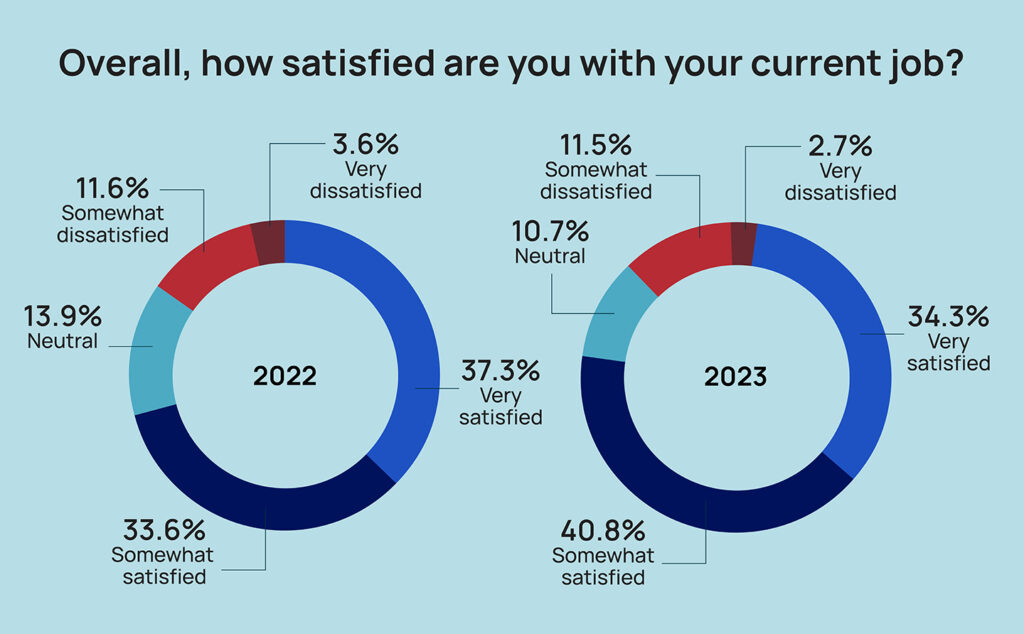
The staffing crisis in long-term care is showing signs of easing, but many building leaders still want higher pay in exchange for the extra work they’re putting in, according to results from the fifth annual McKnight’s Mood of the Market survey.
Overall, however, job satisfaction rose noticeably over the last year. And an overwhelming share of respondents reported they still found their work meaningful, even if fewer believed their efforts were fully appreciated.
Employees last year clamored for more co-workers to improve their job satisfaction. But the most desired change this year was a higher salary, with more than half of survey takers choosing that option. And despite three-quarters (75.1%) reporting being “somewhat satisfied” or “very satisfied” with their current jobs, almost one-quarter (22.6%) said they were “not so well paid” or “not at all well paid.”
The 2023 survey drew more than 500 responses from directors of nursing, assistant directors of nursing, and administrators and their assistants. They sent mixed signals about the meaningfulness of their work, their willingness to remain on the job and the changes today’s employers need to adopt to keep them.

The share of workers “very satisfied” or “somewhat satisfied” with their current job rose about 4%, up from 70.9% in 2022.
Cara Silletto, president and chief retention officer of Magnet Culture, said she’s hearing from clients that some staffing stability has been gained over the last six months. But she cautions that any relief from the workforce shortage shouldn’t be viewed as a return to pre-COVID normalcy. In fact, she believes many nursing home leaders see themselves with a new, lower staffing baseline — one that is leading them to demand better pay even after years of solid increases.
“On this particular question saying more staff will solve my problem, they’re now rolling their eyes and saying, ‘Yeah, yeah, that’d be nice,’” Silletto told McKnight’s Long-Term Care News after reviewing results. “They just want higher salaries because they’re thinking, ‘We’re gonna have to deal with this churn. And so I just need more money because I am never fully staffed. I am never going to get caught up. I am never gonna be not trying to fill tonight’s shift.”
Staffing a ‘smidge’ better
Katie Piperata, a workforce engineer with 15 years experience recruiting for skilled nursing, counters that the boost in satisfaction rates and some of the other positive findings from this year’s survey are reflective of the labor crisis “getting a smidge better.”
She noted the negative “trickle-up” effect of a DON being routinely called to the floor to cover for missing nurses or aides. Administrators then have to step in on some of the DON’s duties, a reality that has hurt satisfaction among both categories of workers in the COVID era.
These workers have also seen less external support as inflation cut into margins and led to regional staffing changes at many nursing home chains.
“Now that we have more staff and staffing is becoming less of an issue, hopefully, corporations that are managing these buildings will start adding back in some of the FTEs that they’ve cut over the last couple years,” added Piperata, with Tampa-based MedBest. “A lot of what I saw cut was more on the regional side, not the administrator or the DONs, but the people that they report to. I’m hoping that some of that support starts coming back because that’s how you mentor your administrators and DONs. You have to have enough people above helping and grooming and growing them.”
Survey finds satisfaction on the line
At National Health Care Associates, which operates 33 facilities in the Northeast, leaders are trying to combat inflationary pressures with fair salary increases and a culture that prioritizes retention. They’ve seen increased demands for raises and higher asks from new candidates, says Anthony Scarpino, the company’s vice president of talent acquisition.
“It’s a factor of the rapid inflationary growth of salaries,” he told McKnight’s. “Your salary may fall behind in a single year.”
That could be one explanation for the 52.2% of respondents who said a higher salary would most improve their job satisfaction. That share was 51.3% among DONs and 52.8% among administrators.

Just 17.5% of all McKnight’s survey respondents said they were “very well paid,” a finding that remained flat from year-to-year, despite recent raises that exceeded historic averages nationally. Among administrators, that figure was 18.5% and it was just 16.1% among nurse leaders.
Nursing home administrator salaries averaged $127,763, up 3.6% from $123,324 in 2022, while directors of nursing saw their average pay climb 4.67% from $103,954 in 2022 to $108,889, according to the annual HCS Nursing Home Salary & Benefits Report.
National currently has no openings in its DON or assistant DON ranks, but the perception that wages are stagnant makes it that much tougher to hire when there is a vacancy, Scarpino added. Strategies to retain rather than replace get high priority at the company.
“I can tell you that we have thought of every bonus incentive, either motivational or retention activity, that is known to man. Depending on the location that you work at, there’s a different combination that may be in place. We’ve tried things in one building that didn’t work and work really well in another building,” Scarpino said. “I think the only time that I’ve seen it more competitive is not necessarily during [the first wave of] COVID, but right after, as we were all trying to open at the same time, we were all trying to return to business.”
Comparison or collaboration?
Although many providers are focused on competing for staff with agencies, travel nurse firms and other local healthcare entities, Silletto says there is a new foe they may not even take into consideration. That’s a massive increase in healthcare pay transparency thanks to social media, publicly available surveys and websites and even new legal requirements for job postings in some states.
“People talk more today about how much money they make than ever before,” she said, also quoting the adage that says “Comparison is the thief of joy.”
And comparisons between DONs and admins may be driving one split identified in the McKnight’s survey: Nearly 23% of DONs said they were “not so well paid” or “not at all well paid,” compared to 14.3% of administrators.
“It never surprises me that a second-in-command is less thrilled with their pay than the top paid person at any organization,” Silletto observed. “A lot of people just think, ‘I should be paid just as much as the next person,’ if they see themselves in a more collaborative role.”
“I honestly think there is nothing companies can do — outside of actually paying more — that can overcome this frustration people find,” she said. “When they learn how much money other people make, it is human nature to feel frustrated or jealous or angry.”
Years of unrelenting stress may also be undercutting the teamwork that so many facilities count on to keep operations stable. The share of respondents saying they feel their contributions are valued by their colleagues “a great deal” fell more than 4%, from 45.7% last year to 41.5% this year.
That doesn’t necessarily equate to dislike of the job, though. For the second year in a row, about 73% of respondents said they found their work “very meaningful.” Among DONs, that share inched up to 75.8%, while 68.7% of DONs reported their work was “very meaningful.”
This is the first in a four-part series revealing the finding of the 2023 McKnight’s Mood of the Market survey. See additional installments at www.mcknights.com/tag/mood-of-the-market/.




